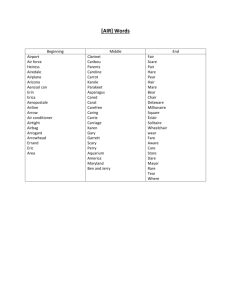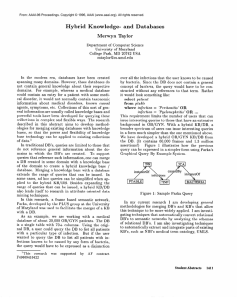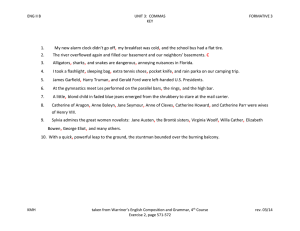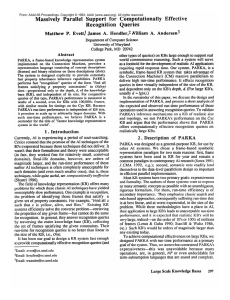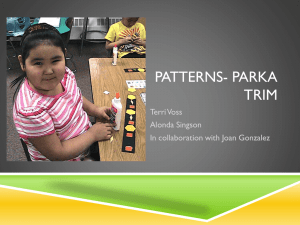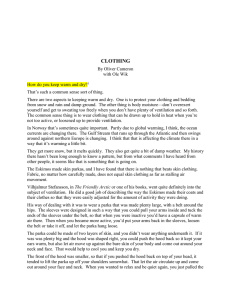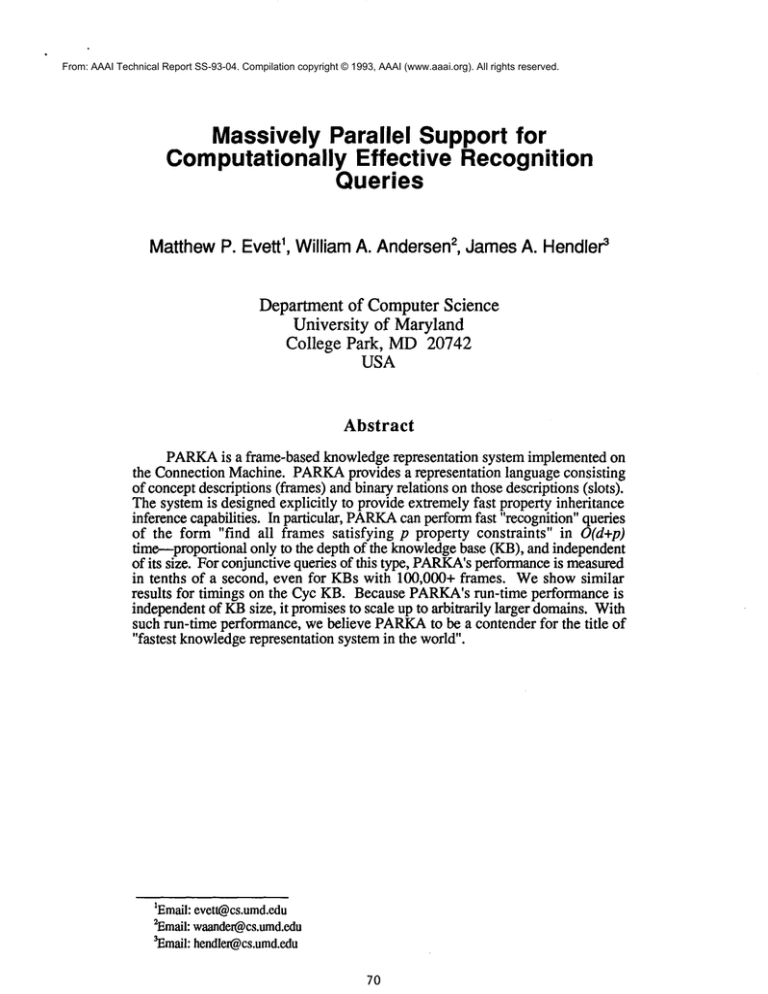
From: AAAI Technical Report SS-93-04. Compilation copyright © 1993, AAAI (www.aaai.org). All rights reserved.
MassivelyParallel Supportfor
ComputationallyEffective Recognition
Queries
2, JamesA. Hendle~
MatthewP. Evett1, William A. Andersen
Department of Computer Science
University of Maryland
College Park, MD20742
USA
Abstract
PARKA
is a frame-based knowledgerepresentation system implemented on
the Connection Machine. PARKA
provides a representation language consisting
of conceptdescriptions (frames) and binary relations on those descriptions (slots).
The system is designed explicitly to provide extremely fast property inheritance
inference capabilities. In particular, PARKA
can performfast "recognition" queries
of the form "find all frames satisfying p property constraints" in O(d+p)
time---proportional only to the depth of the knowledgebase (If, B), and independent
of its size. For conjunctive queries of this type, PARKA’s
performanceis measured
in tenths of a second, even for KBswith 100,000+ frames. Weshow similar
results for timings on the Cyc KB. Because PARKA’s
run-time performance is
independentof KBsize, it promisesto scale up to arbitrarily larger domains.With
such run-time performance, we believe PARKA
to be a contender for the title of
"fastest knowledgerepresentation system in the world".
1Email:evett@cs.umd.edu
2Email:waander@cs.umd.edu
3Ernail:hendlet@cs.umd.edu
70
1. Introduction
Currently AI is going through a period of soul-searching. Ourcritics contend
that the promise of the AI techniques of the 80’s has evaporated, simply because
those techniques did not deliver. It wasn’t that their formalisms and theory were
unacceptable. In fact, they workedfine for relatively small, contrived domains.
Real-life domains, however, are orders of magnitudelarger. Thus, the run-time
performanceof these earlier AI techniques is often completelyunacceptablefor such
domains(and even muchsmaller ones); that is, these techniques, while quite useful,
4.
are computationallyineffective
The field of knowledgerepresentation (KR)offers manyproblems for which
these classic AI techniques have yielded unacceptably slow performance. One
exampleis recognition, the problemof identifying those framesthat satisfy a given
set of property constraints. For example,"Find all x such that x is yellow, alive,
and flies."
Existing KR systems can efficiently
solve the converse
problem--retrieving the properties of any given frame but cannot do the samefor
recognition. In general, they answer recognition queries by traversing the entire
knowledgebase (KB), collecting the set of frames satisfying the given constraints.
Their run-timefor recognitionqueries is therefore no better than linear in the size of
the KB,i.e., O(n).
It has been our goal for the past several years to design a KRsystem fast
enoughto provide computationallyeffective recognition queries (and other types of
queries) on knowledge bases large enough to support real-world commonsense
reasoning. Webelieve that such a systemwill serve as a foothold for the development
of realistic AI applications requiring rapid response time. Our system, PARKA,
is
a symbolic, frame-basedKRsystem that takes advantageof the ConnectionMachine’s
(CM)massive parallelism to deliver high run-time performance. It can effect
recognition queries in time virtually independentof the size of the KB,and dependent
only on the KB’sdepth, d. (For large KB’s, d << lg(n).)
In the remainderof this paper, webriefly discuss the design and implementation
of PARKA.Wepresent a short analysis of the expected and observed run-time
performanceof those operations used in answeringrecognition queries. To validate
PARKA’s
inference mechanismson a KBof realistic size and topology, we test
PARKA’s
performance on the Cyc KB. Weargue that PARKA
offers computationally
effective knowledgerepresentation on realistically large knowledgebases, and as
such, demonstrates that such systems can serve as a basis for computationally
effective AI applications in real-world domains.
~ThetermwascoinedbyShastri.
2. Description
of PARKA
PARKA
was designed as a general-purpose knowledgebase (KB), for use
other AI systems. For PARKA,we chose tO use a frame-based symbolic
representation paradigm for two main reasons. First, frame systems have been
used in knowledgerepresentation for years, and remain a commonparadigm in
contemporaryAI research ([16], [3], e.g.) Second, semantic nets readily lend
themselves to the data-level parallelism design so important in efficient parallel
implementation.
MostKRsystems have just two primary goals: expressiveness and formality.
Theauthors of these systems want to express as manysemantic concepts as possible
with an unambiguous,rigorous formalism. For these systems, run-time efficiency
is of secondary importance. Theyusually emphasizeclassic search and rule-based
approaches, consequently suffering run-time that is at best linear, and at worst
exponential, in the size of the problem. While such methodologiescertainly have
their place in AI, their application to large KB’sleads to unacceptable run-time
performance,and it is expectedthat realistic KB’swill be very large, indeed---on
the order of 10’s or 100’s of millions of frames ([ 12], [19], etc.) Such KB’s
wouldbe orders of magnitudelarger than any existing today.
To achieve computational effectiveness on large KBs, we designed PARKA
with run-time performanceas a primarygoal of the system. To obtain this performance,
we had to constrain PARKA’sexpressiveness somewhat. This was unavoidable
because manyoperations, are, in general, NP or even undecidable for termsubsumptionlanguages that are soundand complete. Recognition, in particular, is
NP, though it is a special case of classification, which can be undecidable [ 14].
So, although PARKA’s
semantics are roughly based upon those of NETL[8] and
KL-ONE
[3], we stayed awayfrom semantic constructs that lacked a computationally
effective implementation(or--worse--those constructs whoseimplementationwould
have rendered existing inference mechansimscomputationally ineffective.) We
believe PARKA’srun-time performance on even very large KBs more than
compensatesfor its somewhatrestricted expressiveness whencomparedto that of
other, serial, KRsystems.
2.1 Design specifics
PARKA
is a basic frame system. Each frame corresponds to a concept to be
represented in the KBand the collection of relations to whichit belongs. Relations
amongconcepts are represented as directed graphs, whosearcs (or links) are stored
as frame pointers in the slots of frames. Properties of frames are represented as
relations for whichthe domainis the frames having the property, and the range is
72
the corresponding property values. The KBcan be viewed as the network formed
by the framesand the links that connect them(i.e., as a semanticnetwork[14]).
Ontologicalrelations (similar to the conceptof "natural kinds", in philosophy)
amongframes are encoded via the IS-A ("is a") relation. The IS-A relation
intimately involved in the calculation of property inheritance inferences (see below)
and, as such, is accorded special status in PARKA.
The subgraphconsisting of all
IS-A links and frames is referred to as the IS-A hierarchy of the net. Nomenclature
similar to that of tree data structures is used to refer to elementsof the hierarchy"for
any node in the subgraph, adjacent node(s) representing superclass(es) are referred
to as parents, and those representing subclasses are called children. All PARKA
IS-A hierarchies are rooted and acyclic.
A small subset of a frame network is shown in Figure 1. The frames are
shownas ovals. Theproperties of each frame are represented by the arcs emanating
from them. Unlabelled arcs are IS-A links.
Key:
r
isa (unlabelled)
slot (bold)
r
Figure 1: Subset of a FrameNetwork
2.2 Inheritance Mechanism.
PARKA,
like most frame systems, employs a property inheritance mechanism
on its IS-A hierarchy. In PARKA,
a frame is said to be explicitly-valued for a
given property if it is incident on a propertylink of that type--that is, if the frame
contains a slot by that name. Anyframe that is not explicitly-valued for a given
property inherits the value of its nearest ancestor(s) (using a metric based
Touretzky’sinferential distance ordering (IDO)) that is explicitly-valued for that
property. BecausePARKA
supports multiple inheritance, it is possible that there
might be more than one such node. In that case, PARKA
must disambiguate
amongthe viable ancestors.
The first version of PARKA
[5 and 7] handled multiple-inheritance--as have
73
manyprevious frame-based KRsystems ([3] is just one)---by using inheritance
path length to disambiguate multiple inheritance paths. The system choose the
ancestor having the shortest IS-A path from the inheritor. This inheritance paradigm
suffers from redundancy, ambiguity, and other problems, and has been soundly
criticized in the philosophical communityas being epistemologically inadequate.
Manyof these criticisms have been detailed by Touretzky[21] and Brachman[1].
The current implementation now uses a top-down, path-based, credulous
inheritance mechanismbased on Touretzky’s IDOmetric to disambiguate multiple
inherited values. The disambiguationworkslike this: assumethe frame in question,
X, is not explicitly valued for the given property, P. Let B be the set of ancestors
{B~,B2, ... } of Xthat are explicitly valued for P. Xtakes Bi’s value for P as its
own,providedBi is an elementof B such that there is no Bj (j ~ i) such that Bj is
IS-A descendantof Bi. If morethan one element of B meets this criterion, Xis said
to be ambiguouslyvalued for property P.
Unfortunately, manyretrieval operations involving top-down, path-based
inheritance mechanisms, including IDO, have been shownto be NP-hard [16]. To
allow the calculation of these operations in a timely manner, we chose to adopt a
somewhatweaker ordering schemefor inheritance disambiguation. Again, let B be
the set of ancestors of Xthat are explicitly valued for property P. X takes Bi’ s
value for P as its own,where B~ is that element of B with the largest topological
number. If more than one element of B meets this criterion, X is said to be
ambiguouslyvalued for property P. The topological number, topo(Z), of a frame
Z, is defined inductively: Topo(rootNode) = 0. For all other frames, Z,
topo(Z)= l+m~c(topo(y)) where C is the set of frames that are parents of Z.
Using this disambiguation metric, PARKA
can calculate inheritance inferences in
O(d) time, independentof KBsize, where d is the ISA-depthof the frame network.
Full IDOdisambiguatesby choosing the ancestor that is "most specific". If
there are two explicitly valued ancestors, Xand Y, but X is also an ancestor of Y,
then Y is morespecific than X, and so its property value is chosen. Ourtopological
disambiguation schemediffers from inferential distance ordering in that it will
arbitrarily disambiguate amongtwo ancestors, V and W, even whenneither is an
IS-Aancestor of the other.
Though PARKA’sdisambiguation mechanismis not quite as powerful as
complete IDO,it is considerably stronger than a simple path-length based scheme.
In particular, it does not suffer from the problemsof redundancynoted in [21]. In
the majority of cases, PARKA’smechanism is equivalent to IDO. PARKA’s
encoding of the Cyc commonsenseKB(see Section 3.4) has revealed no cases
which PARKA
disambiguates an inheritance relation that is ambiguousvia IDO. If
74
Cycturns out to be typical of other, future KBs,then this shortcomingof topologicial
disambiguationpromises to have very little impacton most inferences.
2.3 PARKA’sImplementation on the Connection Machine
PARKA’s
internal representation of a frame consists of a block of processors,
one for each of that frame’s IS-A parents. These processors are contiguous across
the CM’sprocessor address space. Oneprocessor of each block is distinguished as
a referent for all other framespointing to the representedframe.
The slots of each frame are encoded in a slot table, stored in one of the
processorsof that frame’sblock. Thetable is a list of pairs (<property>,<propertyvalue>), each componentbeing a processor address. Figure 2 illustrates the
internal representation on the CMof part of the net shownin Figure 1. The large
rectangles represent the distinguished processor of each block of processors
correspondingto a particular frame. Thesmaller rectangles represent the remaining
processors of those blocks. The square-bracketed values represent the address of
the processor representing the property of that correspondingname.
proc #20
name
USS Maryland
parent
12
slot-table
proc #21
I
proc #22
~
II
65
proc #140
] ....
W2~h3P
<[arms],72>
<[speed],73>
i
I
<[crew],120>
I
I
processor segment for frame "USSMaryland"
Figure 2: Internal CMrepresentation of a small subset of a
frame network
To determine if a frame, Y, is explicitly valued for a given property, P,
PARKA
actually determines the (explicit) value of P for every frame in the KB.
PARKA
scans through the every frame’s slot table in parallel, looking for an entry
corresponding to P. If a matching entry is found in frame Y’s slot table, the
corresponding value stored there is the address of the processor representing the
framethat is the value of property P for frameY. In general, then, slot retrieval is
proportional to the size of the largest slot table in the KB.Becauseproperty values
tend to be scattered across inheritance paths, these tables are typically quite small.
The largest slot table in our implementation of the Cyc KBhad only 43 entries.
Even so, PARKA
maintains a cache of the most recently accessed properties to
75
accelerate explicit property look-up.
3. Performance
To demonstrate that PARKA
can provide computationally effective knowledge
representation, we have implementeda numberof retrieval operations and timed
them on very large KBs. Our tests included inheritance queries on very large,
pseudo-randomKB’s, and recognition queries on the Cyc KB. Wediscuss these
operationsand the results of these timings in this section.
3.1 Inheritance Queries on Large Pseudo-Random KBs
Almost all KBqueries involve some inferencing along the IS-A hierarchy.
This is becausealmost all queries involve havingto calculate the inherited value of a
set of properties for a set of frames. PARKA
uses several data structures to make
such inheritance inferencing very fast, including -- as mentionedabove -- using
multiple processors to represent frames having multiple parents. PARKA
uses an
activation wavepropagation algorithm to calculate the value for a given property of
every frame in the KBin time independentof the size of the network.
First, the IS-A root frame is "activated", forminga nascent activation wave.
At each iteration, this wave is passed downwardalong IS-A links. The activation
wavepropagates synchronously;all nodes in the current "wavefront" simultaneously
activating the incident nodesthat havenot yet beenactivated. Eachsuch iteration is
a propagation step. Because PARKA
is implemented on the CM,each propagation
step is accomplishedwith a single parallel operation.
In detail, at propagationstep i"
1. Frameswith a topological value of i (i.e., those at topological level i) that
are explicitly valued for the property set their wavevalue to k, wherek’ s
high order bits are i, and k’s loworder bits are the frame’spropertyvalue.
2. Everyframe (processor) not explicitly valued for the property in question
that has parent nodesat topological level i-1 "pulls" downthe value of the
activation wavefrom those parents.
3. Non-explicitly valued frames at topological level i choose as their own
activation wave value the largest of those pulled downfrom the parent
frames. Becausethe high order bits of each wavevalue are the topological
level of the origin node, the selected value conformsto the inheritance
schemeoutlined in section 2.2.
Figure 3: The Basic Inheritance Algorithm
Thenumberof propagation steps required to calculate a property value, then,
is equivalent to the depth, d, of the network’s IS-A hierarchy. Consequently,
PARKA’s
run-time for queries, such as "what things are black?", is O(d), and is
76
independent of the size of the KB. To answer a similar query, most serial KR
systems wouldrequire O(bd) time, where b is the average downwardfan-out of the
IS-A network.
The topologies of most successfully implementedlarge KBshave been very
shallow relative to their breadth. It is commonly
believed in the AI communitythat
this shallownesswill persist and probablybe accentuated as net size increases. (In
fact, our PARKA
implementation of the Cye commonsenseKB(see section 3.4),
does enjoy a similarly shallow IS-A topology.) Consequently, we expect PARKA’s
O(d) performanceof inheritance inferences to scale up with larger KBs.
To determine how PARKA
would compare against a serial representation
system, we created a serial version of PARKA,
called SPARKA
("serial-PARKA").
To make the comparison of the timings between PARKA
and SPARKA
as fair as
possible, we implementedSPARKA
as a severely stripped-down version of a more
completeserial implementation(detailed in [ 17]). It has very little functionality
other than for simple property inheritance calculations, but is optimized to effect
those calculations as quickly as possible.
Wetested our analytical predictions of PARKA’s
run-time performance of
simple property inheritance queries by timing PARKA’s
response to examplequeries
on topologies of varying size and depth. To get perspective as to the quality of
PARKA’sperformance we timed SPARKA
on the same queries and networks.
The networks we were working with were to be quite large--up to 128K
5.
nodes As encoding the networks by hand was out of the question, we developed
a number of different algorithms for generating pseudo-randomnetworks with
certain topological characteristics. Thesetechniques are described in [5] and [7].
Our experience with the Cyc KB(see section 3.4) has affirmed our belief that the
topologies we used in measuring PARKA’sperformance are reflective of the
topologies of realistic KBs.
Figure 4 shows PARKA’s
run-time for frame networks of depth 8, and of
varying size. This timing suite isolates the effect of network size on run-time.
These timings support our supposition that PARKA’s
computation of inheritance
6.
queries is independent of network size
Thus, PARKA’sperformance should
scale up to arbitrarily larger KBs.Theserial system’s run-time, on the other hand,
was linear with respect to network size. The figure contains best-fit curves to
highlightthis linear relation.
~Timings
weremadeona "quarter"CM-2,consistingof only 16Kprocessors.
6Actually,wedid observea degreeof correlationbetweenPARKA’s
run-timeandthe size of
the networks.Wehaveexamined
this degradationawayfromour theoreticalperformance
predictions.Theresults of this studyare detailedin [6]. Thedegradation
is completely
accounted
for bythe performance
of the CM’s
interprocessorcommunication
operations.Therun-timeof
theseoperationsdegradesproportionally
withrouternetwork
load.
77
1.8
[]
I parent, serial
O
4 parents, serial
A
1 parent,
1.6-
1.4-
~ 1.2.
<> 4 parents,
O
PARKA
PARKA
.~, 0.8
~0.6
0.4
0.2
0
KnowledgeBase Size (processors)
Figure4: Run-time performanceof inheritance queries on 8-level
networks of varying sizes.
The networks used in the timings were of two topological types: trees (each
frame having exactly one parent) and directed graphs (each frame having between
one and four parents.) Weused the different types of topologies to demonstrate
that PARKA’s
run-time was independent of upwardIS-A fan-out.
A comparison between the serial KR system and PARKAin Figure 4
demonstratesthat the latter remains computationallyeffective even for very large
KBs,while the serial system’s performancebecomesunacceptable for large networks.
Wefully anticipate that this contrast will becomeeven morestark for the much
larger KBsof applications in real-world domains(e.g. [ 12]).
3.2 Recognition Queries on the Cyc KB
The ability to solve recognition queries has driven muchof PARKA’s
design.
Theproblemof recognition is well-knownin the field of knowledgerepresentation
[8, 23, et al]. Recognition is the problem of answering KBqueries of the form:
"find all framesx suchthat P~(x,c,) A P2(x, c2) A ... A Pp(x,cp)", wherePi(x, cJ, Vi,
is a unary predicate true for all frames, x, that havevalue q for property Pi. E.g.:
"Whatobject is most characterized by the following list of property values? .... "
and "what have trunks, tusks, and are big and gray?" Such queries are extremely
time-consumingfor serial-based systems, often running in time no better than
78
O(pn), even on systems employinga highly constrained description language.
PARKA’s
ability to execute inheritance inferences quickly makesit particularly
suitable to recognition. BecausePARKA
can determine which objects have a given
value for a given property in O(d) time, PARKA
can determine which objects
satisfy a set of p property constraints in no morethan O(dp) time, whered is the
depthof the net.
But PARKA
does even better, using a pipelining technique to evaluate
recognition queries in time O(d+p). Because each wave propagation step of an
inheritance inference occurs "in lockstep"--all framesat the sametopological level
calculating their property value simultaneously--pipelining can be added to the
basic process outlined in Figure 3. At each propagation step i, all frames at
topologicallevel j, suchthat p > j > i, retrieve fromtheir parent(s) the waveactivation
value havingto do with the (j- i)-th elementof the set of properties being inferred.
Thus, the completepropagation requires d + p- 1 propagation steps.
3.3 Using Cyc for Validation of PARKA
Wetested our run-time predictions by timing PARKA’sperformance for
recognition queries containing a varying numberof conjuncts on an implementation
of the Cyc KB. Our motivation for using the Cyc KBto evaluate PARKA’s
performance is twofold. First, we want to validate PARKA’s
inference mechanisms
on a KBof large size and realistic topology. BecauseCyc is the largest and most
comprehensive commonsenseKBin existence, it is an obvious choice. A second
and moreexciting motivation is that we envision somefuture version of Cyc being
built on top of a massively parallel substrate, like PARKA,
to makeits reasoning
services fast enoughto be used by an intelligent agent operating in the worldin real
time.
Onthe lowest level, Cycconsists of a framesystem (frames are called "units"
in Cyc), representing assertions (in the form of binary relations, or slots) about
entities in the world. Abovethat level is the CycL"constraint language", which
allows the specification of inferences to be madeabout units in the KB. The
inference mechanismsprovided by CycLrange from the very simple, such as the
slot inverse mechanism(e.g. father(John,Mary) => fatherOf(Mary,John)),to theorem
proving using general "wffs", to unsoundinference methodssuch as analogy.
PARKA
implementsonly someof the inference capabilities provided by CycL,
particularly those having to do with property inheritance. Werepresented only that
subset of Cycthat involved IS-A based property inheritance and ontologies.
The version of the Cyc KBthat we used for our tests contained a total of
26,214 units, 8591 (33%)of which were collections, and 17,623 (67%) instances.
Of the instances, 4031(15%of the total) wereslots (slots are explicitly represented
79
in the Cyc ontology). To accommodatea KBof this size, we used a 16,384
processor CM-2with a virtual processor ratio of 4/1. The maximum
depth of the
KBalong the IS-A relation was23, (i.e., shallow relative to KBsize, as expected.)
3.4 Performance of Recognition Queries on the Cyc KB
For our test on the CycKB,we tried a series of recognition queries of a type
employed by CycLto find those units that are "similar" to a given unit. We
considereda unit to be "similar" to another if it has the sameslot values for some
number of slots exceeding a specified threshold value. Wechose a Cyc unit
(#%Burma-1986)
with a relatively large numberof local assertions (22), and executed
an algorithmto find matchingunits for the first n slots ( 1 < n < 22) of that unit.
WhereasCyc’s serial algorithm finds only an arbitrary numberof matchingunits,
this algorithm exhaustively matchesthe probe against the entire KBsimultaneously,
thus finding a// appropriate matches. This experiment was designed to show
empirically both the O(d+p)complexityof conjunctive recognition queries in PARKA,
and to demonstrate that PARKA
can be used to provide fast matching for analogyrelated functions, a task whichtraditionally has beendifficult for serial systems.
1.4
1.2
_1
1
~0.8
7-
°.2
[’-’ 0.6
0.4
0.2
O0
5
10
15
20
25
Numberof Conjuncts
Figure5: Run-time performanceof recognition queries of various
sizes on the PARKAimplementation of the Cyc KB
As Figure 5 clearly shows, the time required to perform recognition queries
grows only linearly in the numberof conjuncts, p, and overall performance, even
for a query of 22 conjuncts, is excellent. Therun-time matchesthe O(d+p)performance
predicted by analysis. This performance comparesvery favorably with recognition
queries on serial systems, which require O(pn) time for the samequeries, where n
80
is the size of the KB. Recognition queries in PARKA
are, thus, independent of
KBsize, and should scale up to arbitrarily larger domains. Indeed, in [10] we
report sub- one-secondrun-time performanceof recognition queries in a case-based
planning system using KB’s of over 100,000 frames. This is a speed-up of more
than 10,000 over the highly optimized serial version of PARKA.
4. Future work
PARKA
was intended as a basis for large AI systems. The implementation of
the Cyc KBin PARKA
was merely the first of what we hope will be a series of
uses of PARKA
in other large AI systems. Potential uses for PARKA
include
case-based AI systems, as the basis of a massively parallel knowledgeserver, and
as part of a knowledge-mining system. In addition, we plan to examine how
PARKA
might be morefully integrated into the Cyc representation system, proper.
Also, we have implemented a simple version of PARKA
on the MIMD
CM-5.
Preliminary results show that we should be able to represent KBsof over 1M
frames on a 1K-processor CM-5and obtain run-time performance nearly an order
of magnitude better than the results in this paper. Because the CM-5is a MIMD
machine(though we use it as a SPMD
machine), we plan to use an active messaging
scheme[22] to increase the flexibility of PARKA’s
memoryassociation schemes,
and to increase the use of pipelining in inferencing.
5. Conclusion
Using KBswith over 100,000 frames, we have shown that PARKA
computes
property inheritance and recognition queries in time independentof the size of the
KBand dependent only on network depth. The run-time of these operations is in
the tenths of seconds. This performance compares very favorably to serial
representation systems. Becauseour empirical evidence so far has supported our
analytical claims, we believe that PARKA’s
performance will scale up to even
larger KBs,even to the those necessitated by memorybased reasoning7 technology.
Weargue that PARKA’s
performance for these operations has demonstrated
that it can offer computationallyeffective knowledgerepresentation on realistically
large KBs. This in turn, demonstrates that massively parallel KRsystems can
serve as a basis for large AI applications in real-world domains.
Acknowledgments:
The author wishes to thank the SystemsResearch Center at the University of
7Weuse the term"MBR"
in a broadersensethando StanfiU&Waltz[19], to includesuch
paradigms
as case-based
reasoning
([9], [10],and[11],e.g.).
81
Maryland,for their early support in this research, and for the continuinguse of their
hardware in the development of PARKA.The authors also wish to thank the
University of MarylandInstitute for AcademicComputingServices (UMIACS)
and
Thinking MachinesCorp. for the use of their Connection Machines. The support
staff at both institutions wasvery helpful during the developmentof PARKA.
This work has been supported by AFOSRgrant 01-5-28180, ONRgrant
N0014-88-K-0560, and NSFgrant 1R1-8907890.
82
References:
1.
2.
3.
4.
Brachman,R.J. I Lied about the Trees. A/Mag.6, 3 (Fall, 1985).
Brachman, R.J. and Schmolze, J.G. An Overview of the KL-ONEKnowledge
Representation System. Cog. Sci., 9, 2 (April-June 1985).
J. Computersand Mathematicswith Applications m special issue on semantic networks,
23(2-5), 1992.
DeMara,R. and Kitano, H. PACEBenchmarkfor Parallel AI Architectures. Tech. Rep.
IMPACT-92-004-USC/CMU,
and PKPL92-5, Department of EE - Systems, University of
Southern California, and School of ComputerScience, Carnegie MellonUniversity, 1992.
5.
Evett, M.P., Spector, L. and Hendler, J.A. Massively Parallel Frame-BasedProperty
Inheritance in PARKA.
To appear in Journal for Parallel and Distributed Computing.
6.
Evett, M.P. and Hendler, J.A. Degradation of Interprocessor CommunicationOperations on
the Connection Machine. Tech. Rep., Departmentof ComputerScience, Univ. Maryland,
College Park, November,1992.
Evett, M.P. and Hendler, J.A. An Update of PARKA,
a Massively Parallel Knowledge
Representation System. Tech. Rep., CS-TR-2850,Department of ComputerScience, Univ.
Maryland, College Park, February, 1992.
Fahlman, S.E. NETL:A System for Representing and Using Real WormKnowledge. MIT
Press, Cambridge, MA,1979.
7.
8.
9.
10.
11.
12.
13.
Hammond,K. Case-Based Planning: Viewing Planning as a MemoryTask. Academic
Press, 1989.
Kettler, B.P., Hendler, J.A., and Andersen,W.A.Fast, Frequent, and Flexible Retrieval in
Case-BasedPlanning. Departmentof ComputerScience, University of Maryland, College
Park, MD,Oct. 1992
Kitano, H. and Higuchi, T. Massively Parallel Memory-Based
Parsing. Proceedings of
IJCAI-91, 1991.
Lenat, D.B. and Guha, R.V. Building Large Knowledge-BasedSystems. Addison Wesley,
Reading, Mass., 1990.
Moldovan,D., Lee, W., and Lin, C. SNAP:A Marker-Propagation Architecture for
KnowledgeProcessing. Tech. Rep. CENG89-10, Dept. Electrical Engineering-Systems,
University of Southern California, Los Angeles, CA,Sept. 1989.
14. Nebel, B. Terminological ReasoningIs Inherently Intractable. AIJ, 4 3, 2 (May, 1990).
15. Selman, B. and Levesque, H. The Tractability of Path-BasedInheritance. Proceedingsof
IJCAI-89, Morgan-Kaufman,San Mateo, CA, 1989.
16. Sowa, J. (ed.) Principles of Semantic Networks. Morgan-Kaufman,San Mateo, CA, 1991.
Tech. Rep.
17. Spector, L., Evett, M. and Hendler, J.. KnowledgeRepresentation in PARKA.
TR-2409, Departmentof ComputerScience, University of Maryland, College Park, MD,
Feb. 1990.
18. Spector, L., Andersen, W., Hendler, J.A., Kettler, B., Schwartzman,E., Woods,C. and
Evett, M.P. KnowledgeRepresentation in PARKA
-- Part 2: Experiments, Analysis, and
Enhancements. CS-TR-2837, UMIACS-TR-92-16,
Department of Computer Science, Univ.
Maryland, January 1992.
19. Stanfill, C. and Waltz, D. TowardMemory-BasedReasoning. Communicationsof the
ACM,Vol. 29, No. 12, December1986, pp. 1213-1228.
83
20.
21.
22.
23.
Tate, A. Project Planning Using a Hierarchic Non-linear Planner. Research Report No. 25,
Departmentof Artificial Intelligence, University of Edinburgh,1976.
Touretzky, D.S. The Mathematics oflnheritance Systems. MorganKaufmann,Los Altos,
CA, 1986.
VonEicken, T., Culler, D., Goldstein, S. and Schauser, K. Active Messages: a Mechanism
for Integrated Communicationand Computation. Tech. Rep. UCB/CSD
92/#675, Computer
Science Division, EECS,University of California, Berkeley, CA.
Wilensky, R. SomeProblems and Proposals for KnowledgeRepresentation. Tech. Rep.
UCB/CSD
86/294, University of California, Berkeley, May1986.
84

